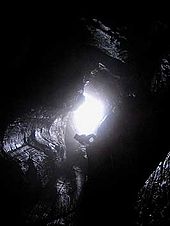Shaft cave


The cave type of the shaft cave consists of shaft- like, predominantly vertical passages. In this context, the term “ shaft ” is used quite generally for more or less vertical cave passages leading downwards. Their vertical extent ranges from a few meters to several hundred meters in depth. If several shafts follow one another, one speaks of shaft steps. The shaft cross-sections are often approximately elliptical and widened bell-shaped downwards.
Depending on the area considered, the respective local names are used, such as Gouffre or Aven (France), Sima (on the Tepuis in South America) or about 天坑 , Tiānkēng - "Himmelsgrube" (China). If a shaft is discovered from below, in cave exploration one speaks of a chimney (or chimney) and refers only to the different - much more difficult - navigation technique.
Shafts are usually the single rope technique ( single rope technique traveled SRT).
Shaft caves are common in the Alps , but are also common in other karst landscapes around the world.
The world's largest shaft cave is the Xiaozhai Tiankeng . It is located in the district of Fengjie in the administrative district of Chongqing in southwest China . At a depth of 666.3 m, it measures 633 m in diameter at the edge and 522 m at the bottom.
The deepest shaft cave in Germany is the " giant thing " in Untersberg near Berchtesgaden . The name originated when the imposing sinkhole in which the shaft begins was discovered. The depth of the cave is 1,149 m, the length 21,300 m (as of October 2018).
See also
Individual evidence
- ↑ Giant thing shaft cave. Retrieved February 26, 2019 .
